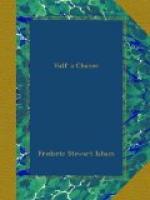“If?” cried Sir Charles. “There isn’t any ‘if.’ Three finer animals man never threw leg over, judging from report,” he explained to John Steele. “Stud farm’s about a mile in the opposite direction from Strathorn House. Mind a little jog to the farm first?”
“Not at all!” John Steele had been looking thoughtfully toward the door that had closed upon the man whose quick regard he had detected. “Only, if you will allow me to make a counter proposal,—Strathorn House, you say, is near; I am in the mood for exercise, after sitting so long, and should like to walk there.”
“By all means,” returned the other, “since it’s your preference. Pretty apt to overtake you,” he went on, after giving his guest a few directions. “Especially if you linger over any points of interest!”
The trap drew up; the two men separated. Sir Charles rattled briskly down one way, Steele turned to go the other. But before setting out, he asked a casual question or two of the landlord, relating to the occasional “gentleman from London”; the host, however, appeared to know little of any cosmopolitan visitors who had happened to drift that way, and John Steele, eliciting no information in this regard, finally started on his walk. Whatever his thoughts, many quaint and characteristic bits of the town failed to divert them; he looked neither to the right, at a James I. sun-dial; nor to the left, where a small sign proclaimed that an event of historical importance had made noteworthy that particular spot. Over the cobblestones, smoothed by the feet of many generations, he walked with eyes bent straight before him until he reached an open space on the other side of the village, where he paused. On either side hedges partly screened undulating meadows, the broad sweeps of emerald green interspersed here and there with small groups of trees in whose shadows cattle grazed. A stream with lively murmur meandered downward; in a bush, at his approach, a bird began to sing, and involuntarily the man stopped; but only for a moment. Soon rose before him the top of a modest steeple; then a church, within the sanctuary of whose yard old stones mingled with new. He stepped in; “straight on across the churchyard!” had been Sir Charles’ direction. John Steele moved quickly down the narrow path; his eye had but time to linger a moment on the monuments, ancient and crumbling, and on headstones more recently fashioned, when above, another picture caught and held his attention.
Strathorn House! A noble dwelling, massive, gray! And yet one that lifted itself with charming lightness from its solid, baronial-like foundation! It adorned the spot, merged into the landscape. Behind, the forest, a dark line, penciled itself against the blue horizon; before the ancient stone pile lay a park. Noble trees guarded the walks, threw over them great gnarled limbs or delicately-trailing branches. Between, the interspaces glowed bright with flowers; amid all, a little lake shone like a silver shield bearing at its center a marble pavilion.




